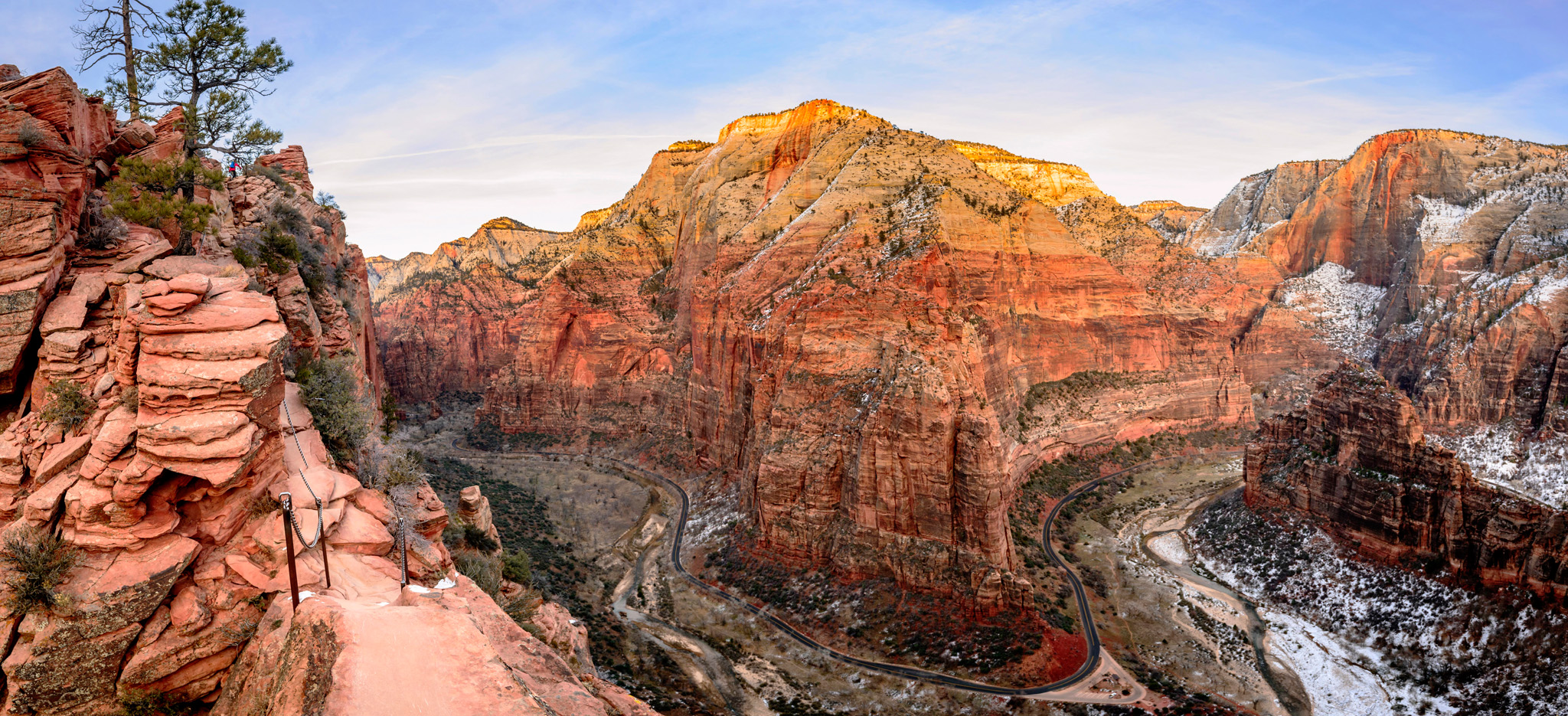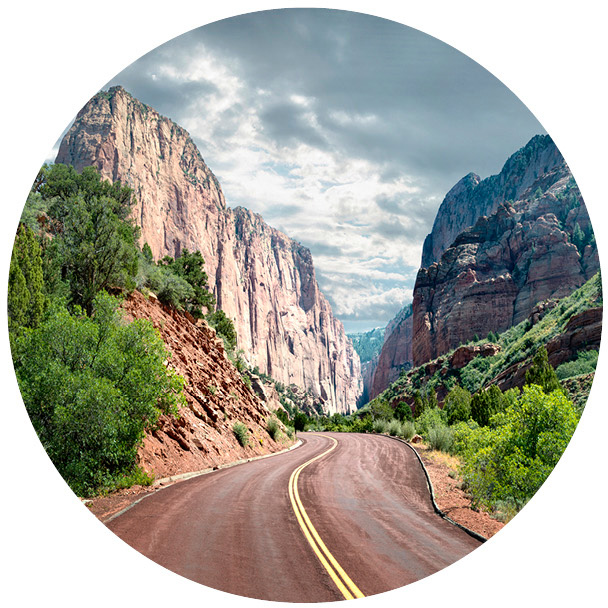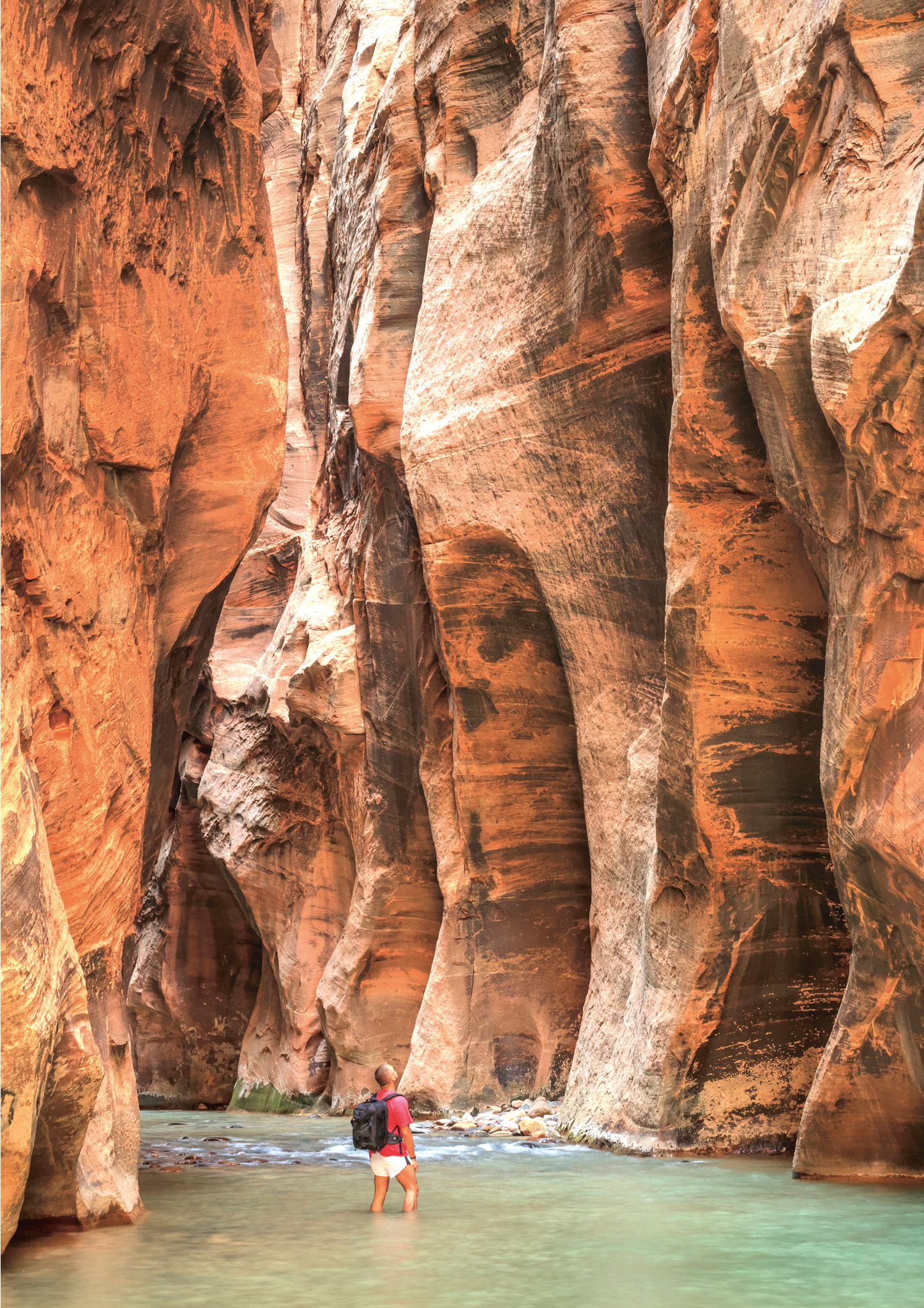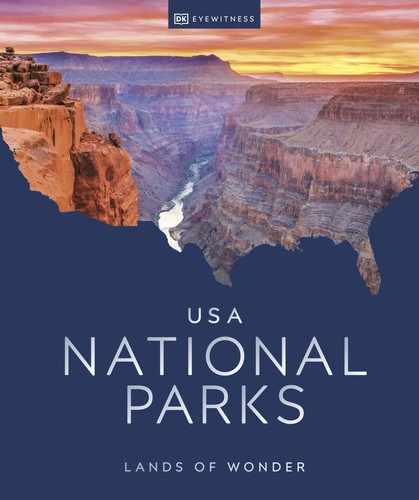
Utah
ZION
ESTABLISHED 1919
Zion is a magical and majestic wonderland cut from sandstone and sky. With towering walls, impossibly tight canyons, and adventures both great and small, this is Utah’s most iconic national park.
Utah’s first national park delivers big on beauty and grandeur. Everywhere you turn, you’ll find narrow slot canyons, bulwarklike towers of sandstone, deep emerald pools, and canyons the color of fire—all, as the name suggests, in biblical proportions.
The natural balance of the desert ecosystem here is delicate, intricate, and marvelously complex. In the “low” elevations of 3,700 ft (1,127 m) up to the heady heights of 8,700 ft (2,651 m) lives a remarkable array of plant and animal life. Along the riverbanks of the Virgin River, find hanging gardens of ferns, carpets of humble mosses, and fields of wildflowers—with names like western wallflower, showy stoneseed, and shooting star. Giant cottonwoods stand tall amid lush wetlands, and above the valley floor, yucca, cactus, juniper, and desert grasses run riot.

The agile, stealthy mountain lion is a solitary, carnivorous hunter
Wondrous wildlife
The landscapes provide habitats for all kinds of wildlife, from top predators like mountain lions, to bighorn sheep, mule deer, and foxes. Some 291 species of bird are cataloged in the park. Look up to the bluebird-colored Utah skies to see the rare California condor. Saved from the brink of extinction and reintroduced into the wild, these superb gliders are massive, with wingspans stretching to 10 ft (3 m).

Visitors can take in the kaleidoscopic colors of the canyon from the vertiginous heights of trails and overlooks
A world of adventure
Zion has no shortage of activities for adventurers of all skills and interests. For sightseers, there’s an informative narrated bus tour that explains park history and ecology. Cyclists can pedal the 7-mile (11-km) Zion Canyon Scenic Drive instead. Once you hop off the park bus or your bike, that’s when the real adventures begin.
Kids love taking part in the ranger-led activities and applying to become official Junior Rangers. Sunrise and sunset are truly bewitching hours. Find a spot to yourself and watch as canyon walls ignite in bursts of pink and orange. After the sun sets, the moon rises and the stars come out, and many head to the Pa’rus Trail for a night walk to see the Milky Way in all its glory.
![]()
The best shot is from Observation Point, where you’ll see nearly all of the Grand Canyon’s attractions.
Unrivalled canyoneering
Zion has some of the best canyoneering in the world. Nearly everyone starts their trip by tackling the celebrated Narrows, above the Temple of Sinawava. Wading through knee- to waist-deep waters in the Virgin River, with skyscraping 1,000 ft (300 m) walls on each side, you head deep into canyon country. More technical routes in The Subway (aptly named, as the canyon walls round up on all sides and feel like they were inspired by New York City subways) and Orderville Canyon give experienced hikers a chance to escape the crowds and visit farther into uncharted territory. There is also excellent rock climbing to be had—mostly big-wall climbs aimed at experts. It’s always fun to scan the rock face for parties making their way up the sheer cliffs of iconic routes like The Moonlight Buttress. On two established bouldering areas, the young (and young at heart) can play on the sandstone rocks.
The road to serenity
Of the myriad hikes here, some require permits and limit group size. From Zion Canyon, hikes match every ability and taste. You’ll find short valley loops as well as all-day affairs that ascend clear to the tip of Angels Landing. In the Northwest corner, Kolob Canyon has a good selection of trails well away from the main canyon crowds. Beautiful backpacking trips take you into primitive wilderness, where the only noises you’ll hear are the whispering of pines and the sweet sound of solitude.
Birding beauty
With a pair of binoculars and a keen eye on the horizon, you can spot a huge variety of birds in just a few short hours. The iconic species to be on the watch for are some of the top predators of the sky: the peregrine falcon, bald eagle, California condor, and Mexican spotted owl. Along with the California Condor, the peregrine falcon nests in the park, having found a safe haven to similarly recover their numbers after nearly being wiped out. The desert wildflowers and riparian habitats make this a good spot to see hummingbirds, too, including the black-chinned varieties.

Overhangs on trails like Weeping Rock and Riverside Walk can provide shade from the sun
Day Hikes

Popular ▷ Angels Landing, 5.4 miles (8.6 km) round trip. If you’re going on just one hike during your visit, this is it. This is on a ridiculously steep trail that climbs several switchbacks before taking you to the top of Angels Landing, where the land spreads before you.
Family-friendly Emerald Pools, 3 miles (5 km) round trip. This hike is a perfect mix of ease and adventure, and leads to a series of pools and waterfalls. The delicate pools are off-limits for swimming.

Spectacular ▷ Canyon Overlook 1 mile (1.6 km) round trip. For remarkable views of Pine Creek Canyon and lower Zion Canyon, head to this super-short hour- long hike accessed near the east entrance of the Zion–Mount Carmel Tunnel. Views are best at sunrise and sunset.

Historic ▷ Kolob Canyon Trail, 1 mile (1.6 km) round trip. This trail takes you into a narrow box canyon with 1,700-ft (500-m) walls above to the Double Arch Alcove. There are fascinating geologic formations along the way, and you’ll pass historic homestead cabins dating to the 1930s.
FOCUS ON
The Geology of Zion
This is the Colorado Plateau, just one step in the Grand Staircase that leads down to the Grand Canyon. At the heart of this mystical landscape are the towering Navajo sandstone formations, formed over millennia by wind, rain, continental uplift, and the powerful Virgin River. Upstream from the Temple of Sinawava, this fierce little river continues to gouge the landscape, carving its way through the hardened Navajo sandstone to the softer Kayenta Formation down below.


Hikers have to get their feet wet to see the 1,000-ft (300-m), neck-craning views of The Narrows—there are no trails on the route
